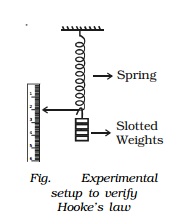Chapter: 11th 12th std standard Class Physics sciense Higher secondary school College Notes
Elasticity: Stress, strain Elastic limit, Hooke's law
Elasticity
When an external force is applied on a body,
which is not free to move, there will be a relative displacement of the
particles. Due to the property of elasticity, the particles tend to regain
their original position. The external forces may produce change in length,
volume and shape of the body. This external force which produces these changes
in the body is called deforming force. A body which experiences such a force is
called deformed body. When the deforming force is removed, the body regains its
original state due to the force developed within the body. This force is called
restoring force. The property of a
material to regain its original state
when the deforming force is removed is called elasticity. The bodies which
possess this property are called elastic bodies.
Bodies which do not exhibit the property of elasticity are called plastic. The
study of mechanical properties helps us to select the material for specific
purposes. For example, springs are made of steel because steel is highly
elastic.
Stress and strain
In a deformed body, restoring force is set up within the body which
tends to bring the body back to the normal position. The magnitude of these
restoring force depends upon the deformation caused. This restoring force per unit area of a deformed body is known as stress.
Stress = restoring force/ area N m-2
Its dimensional formula is ML-1T-2.
Due to the application of deforming force, length, volume or shape
of a body changes. Or in other words, the body is said to be strained. Thus, strain produced in a body is defined as the
ratio of change in dimension of a
body to the original dimension.
Strain = change in dimension
/ original dimension
Strain is the ratio of two similar quantities.
Therefore it has no unit.
Elastic limit
If an elastic material is stretched or
compressed beyond a certain limit, it will not regain its original state and
will remain deformed. The limit beyond which permanent deformation occurs is
called the elastic limit.
Hooke's law
English Physicist Robert Hooke (1635 - 1703) in the year 1676 put
forward the relation between the extension produced in a wire and the restoring
force developed in it. The law formulated on the basis of this study is known
as Hooke's law. According to Hooke's law, within
the elastic limit, strain produced in a
body is directly proportional to the stress that produces it.

(i.e) stress α strain
Stress / Strain = a constant,
known as modulus of elasticity.
Its unit is N m-2
and its dimensional formula is ML-1T-2
Experimental verification of Hooke's law
A spring is suspended from a
rigid support as shown in the Fig.. A weight hanger and a light pointer is
attached at its lower end such that the
pointer can slide over a scale graduated in millimeters. The initial reading on
the scale is noted. A slotted weight of m
kg is added to the weight hanger and the pointer position is noted. The same
procedure is repeated with every additional m
kg weight. It will be observed that the extension of the spring is proportional
to the weight. This verifies Hooke's law.
Related Topics